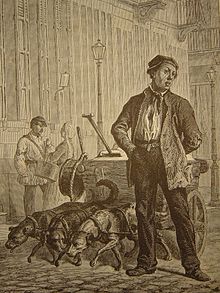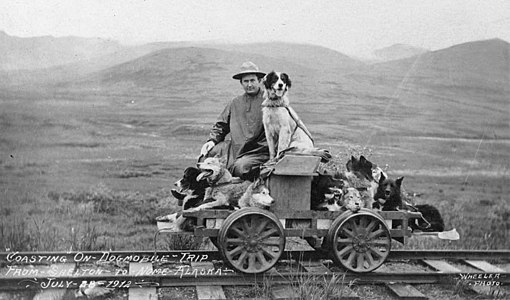Dog cart
Dogs cars or Dogcarts are now in the area of canine sports summer training car for dogs . They can be used as draft animals with healthy, strong, adult dogs . In chariot races or skill courses, dog carts are brought to the start, whereby different categories (with one or more dogs) are taken into account and one or more people can be transported.
In some wagons, the dog is clamped in a drawbar with a padded harness . The bracket ensures that the direction of travel is determined by the driver alone. This is an advantage for untrained dogs, as they do not have to take the desired direction independently when called. If the dogs are leashed in front of a wagon instead of the drawbar, this presupposes that a lead dog can implement the calls of the driver ( musher ). The wagons have different weights depending on their suitability for one or more dogs.
Road traffic regulations in the Federal Republic of Germany
In road traffic , the dog cart is classified and approved as a carriage and must therefore have a bell , vehicle lighting and brake . Dog-carts are animal wagons, so on the road and on a dirt road a vehicle within the meaning of the law. They are not subject to any approval process, but operational safety requirements still apply . With a width of more than one meter, a white reflector must be attached on both sides at the front and a red reflector at the rear , with a width less than one meter a single reflector is sufficient. If the total weight exceeds 150 kilograms, a parking brake is mandatory. A driving license is not required, but a suitable guide who is familiar with the animal is required .
history
While dog carts are used today in the fields of sport and leisure , they were in use as a means of transport from the Middle Ages into the 20th century . In Germany , after the Second World War , dog carts with pulling dogs were again used because other transport options were not sufficiently available.
In order not to expose the dogs to the will of the team leader, laws were passed. According to this, since April 23, 1887 a certificate from the royal district veterinarian about the suitability of the dog had to be proven, without which the local police authority was not allowed to issue the permit.
The restraint had to enable the dogs to lie down while being held, and a pad and blanket to protect them from the cold and wet, as well as a drinking bowl, had to be carried. Violations were 30 Mark occupied or to 60 mark fine withdrawn permission for repeated non-compliance.
The guide was obliged to help his dogs pulling in poor road conditions. Sitting on the wagon was forbidden and required a special permit. B. was justified with a physical disability . This special permit was not granted, for example, "... if he goes to the villages and gets drunk there so that his wife has to pick him up with it."
The somewhat strange idea of a cynophère in France, a three-wheeled vehicle driven by dogs on two wheels, did not take hold .
Pup mobile Alaska
- Pup mobile (1912)
The Pup-mobile is a drawn from a dog team coach , the beginning of 1900 as a rail vehicle in Alaska for the transport of persons was used. It was used on the route between Shelton and Nome . Frank G. Carpenter documented this in 1923 in his book Alaska - Our Northern Wonderland . On the sloping part of the route, the dogs got on the wagon and drove with them.
Dogcart
The English term dogcart was used in the early days of automobile construction in England , France and Germany for a small, light, often electrically operated type of car that was supposed to transport no more than one person, the driver. With the model CGA dogcart who won Belgian Camille Jenatzy twice the land speed record (January 17, 1899: 66.66 km / h and 27 January 1899, 80.35 km / h).
The term dogcart is also used to refer to a light two-wheeled cart pulled by a dog or horse.
Art and literature
Dog cart, France 1905
Adolph von Menzel created a painting in 1868 with the title The Draw Dog and the Cat . When Theodor Fontane is several times by pulling dogs talk, as in his novel trials tribulations (1888), where a gardener in possession is of such an animal. In her autobiographical work Herbstmilch (1985) Anna Wimschneider mentions a pulling dog; here it is an egg dealer who uses the dog.
Social status symbol
As described, for example, in the home calendar of the Hersfeld-Rotenburg district , in the past it was sometimes considered a sign of social advancement to be able to afford a dog team. This was currently the meaning for "got on the dog ". Usually traders and peddlers otherwise had to transport their goods on their own, on wheelbarrows , handcarts , backpack baskets , a thrown cross bag or offered them in a vendor's tray .
The expression “got on the dog” as a phrase today has the meaning of “got down”.
Dog buggy
Under the designation "pet stroller" or "dog buggy" there are recently stroller-like dog carts in which dogs or cats are driven around.
See also
literature
- Susanne Preuss The draft dog - then and now (Kynos Sport and Games). Kynos Verlag , 2002, ISBN 3-933228-42-5 .
Web links
- Use of a dog cart in Kaarst after the Second World War
- Historical photographs of dog car as transport (English)
- "... got on the dog", dog teams in the Werra valley
Individual evidence
- ↑ Marburg State Archives archived under file numbers 180 HEF 1365 and 1369. B. Miehe, Gershausen, home calendar of the Hersfeld-Rotenburg district (1986, p. 69)
- ^ Frank G. Carpenter: Alaska - Our Northern Wonderland. 1923, Chapter XXV: The Dog Derby of Alaska, p. 197 ( book pages and photos ).
- ↑ Dogcarts history / English
- ^ Ferdinand Sauerbruch , Hans Rudolf Berndorff : That was my life. Kindler & Schiermeyer, Bad Wörishofen 1951; cited: Licensed edition for Bertelsmann Lesering, Gütersloh 1956, p. 110 (“[…] I loved his white horse, had him harnessed to a dog cart, and so we - my wife and I - drove over the heights, through the valleys and through the Forests [...] ").
- ↑ Marburg State Archives archived under file numbers 180 HEF 1365 and 1369. B. Miehe, Gershausen, home calendar of the Hersfeld-Rotenburg district (1986, p. 69)








